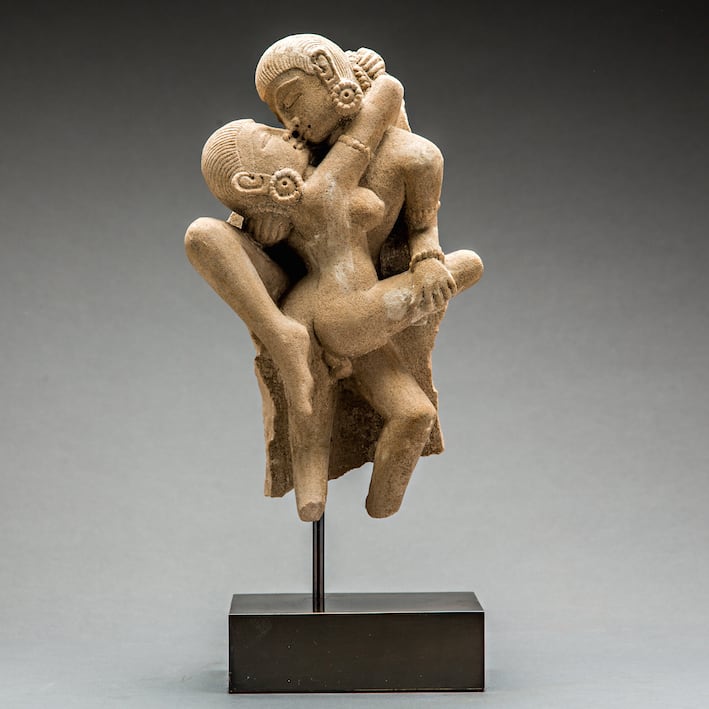Fragment from a Temple Depicting a Karma Sutra Scene, 300 CE - 600 CE
Sandstone
24.9 x 15.2 cm
9 3/4 x 6 in
9 3/4 x 6 in
OF.267
This beautifully rendered sandstone sculpture of two lovers in an energetic position was made in ancient India, and is based upon the contents of the Kama Sutra (see below). The...
This beautifully rendered sandstone sculpture of two lovers in an energetic position was made in ancient India, and is based upon the contents of the Kama Sutra (see below). The position – the man leaning back and pulling the woman onto him, their right legs wrapped around the others’ left legs – is known as Suspended Congress. The detailing of hair, faces and jewellery on arms, ears and in the coiffures is exceptional. The tenderness and delicacy of touch in their expressions and the coiled tension of their poses make this piece stand out among others of the genre.
The Kama Sutra is commonly and mistakenly believed to be a lovers guide at best, pornography at worst. In fact, this epic work, written by Vatsyayana Mallanaga in the third century AD, is a very important work of scholarship that incorporates anthropology, sociology, psychology and philosophy as much as sexology. It is based upon standard philosophical principles. Many Indian philosophies are divided into the four main goals of life, to include Dharma (virtuous living), Artha (material prosperity), Kama (sensual pleasure) and Moksha (liberation). This holistic attitude towards life has stymied those who attempt to dismiss the Kama Sutra as indulgent pornography, although it is true that it is the somewhat graphic images that have seen the greatest exposure and public popularity.
The Kama Sutra is divided into 1250 verses over 36 chapters. As stated above, many of these are comparatively mundane, featuring sections on personal motivation, manners, demeanour, business comportment, the importance of learning foreign languages and so forth. Further chapters include marriage and selection of a partner, civilities, appropriate social behaviour when with one’s spouse, and, eventually, sexual behaviour, fully illustrated to underline the practical issues and cosmological significances. Sex as part of the physicality that is a necessary part of life is underlined throughout, using parables from healthy and unhealthy social and sensual relationships to demonstrate the points made.
Ancient Indian artists often carved and painted the 64 sexual positions shown in the Kama Sutra, as these were considered to be perfectly valid as subjects, both aesthetically and philosophically. They were often arranged around the courtyards of temples and other public spaces in a frieze, and this is the likely source of the current piece. The Gupta period is noted for the dynamic exuberance of their sculptural works, as can be clearly seen here.
This is an impressive piece of ancient Indian art.
The Kama Sutra is commonly and mistakenly believed to be a lovers guide at best, pornography at worst. In fact, this epic work, written by Vatsyayana Mallanaga in the third century AD, is a very important work of scholarship that incorporates anthropology, sociology, psychology and philosophy as much as sexology. It is based upon standard philosophical principles. Many Indian philosophies are divided into the four main goals of life, to include Dharma (virtuous living), Artha (material prosperity), Kama (sensual pleasure) and Moksha (liberation). This holistic attitude towards life has stymied those who attempt to dismiss the Kama Sutra as indulgent pornography, although it is true that it is the somewhat graphic images that have seen the greatest exposure and public popularity.
The Kama Sutra is divided into 1250 verses over 36 chapters. As stated above, many of these are comparatively mundane, featuring sections on personal motivation, manners, demeanour, business comportment, the importance of learning foreign languages and so forth. Further chapters include marriage and selection of a partner, civilities, appropriate social behaviour when with one’s spouse, and, eventually, sexual behaviour, fully illustrated to underline the practical issues and cosmological significances. Sex as part of the physicality that is a necessary part of life is underlined throughout, using parables from healthy and unhealthy social and sensual relationships to demonstrate the points made.
Ancient Indian artists often carved and painted the 64 sexual positions shown in the Kama Sutra, as these were considered to be perfectly valid as subjects, both aesthetically and philosophically. They were often arranged around the courtyards of temples and other public spaces in a frieze, and this is the likely source of the current piece. The Gupta period is noted for the dynamic exuberance of their sculptural works, as can be clearly seen here.
This is an impressive piece of ancient Indian art.



